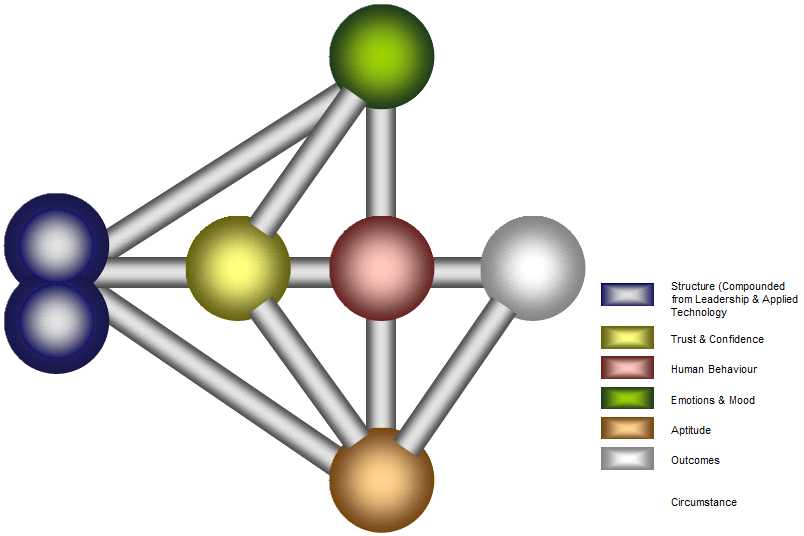 René Van Someren René Van Someren
The Elementary Model of Organisational Processes (EMOP): The essentials of all organisations, and how they mutually correlate.
Posted May 3, 2017
Adapted from:
Van Someren, R., 2014, Aptitude and Attitude as Constraints and Enablers in Organisation Development: An Elementary Model of Organisational Processes, The Hague, Van Someren, ISBN/EAN: 9789079641086
Van Someren, R., 2016, Fundamentals of Organisations, The Hague, Van Someren, ISBN/EAN: 9789079641109
See also: René Van Someren's blog.

Some time ago, I obtained my Ph.D. on an interdisciplinary dissertation. Three main subjects that I addressed in that dissertation are:
- Thought to Behaviour (TtB). Even though there has
been much agreement for quite some time about the importance of attitudes
in bringing about human behaviour, it still seemed unclear how this
actually works. Thought to Behaviour is proposed to serve as an
integrative explanation of human behaviour.
- The Elementary Model of Organisational Processes
(EMOP). This model is the result of identification of aspects that are
essential to all organisations, regardless of their type or size. The
model also illustrates how those organisational aspects tend to correlate
with one another.
- The Elementary Model Questionnaire (EMQ). By
inferring organisation members’ attitudes towards elementary aspects,
identified in EMOP, the EMQ serves to quantify organisational behaviour.
EMOP is illustrated in the image above. The following is a brief sketch of EMOP. It consists of the following variable elements:
 Structure Structure
Structure is illustrated as the double sphere at the
left-hand side of the model. It consists of the structure components
'Leadership' and 'Applied Technology'. This is where most organisational processes
start and from where many of them are directed and controlled. A boss issues an
order, an order is received by telephone, E-mail or another computer
application; organisation members are given verbal or written directions on how
to perform certain tasks, and so on.
 Trust & Confidence Trust & Confidence
Each organisation member attributes a certain amount of
trust and confidence to him/herself, his or her colleagues, leaders, clients,
abilities, information, applied technology, et cetera. Trust is attributed via
perception and emotions, not by factuality.
 Emotions & Mood
Emotions & Mood
Someone who is in a good mood may act differently than he or
she does while being in a bad mood. Mood and emotions affect organisation
members’ behaviour both during social interaction and while acting alone.
 Aptitude Aptitude
For organisational processes in general, important relevant aptitudes relate to:
a. Understanding leadership directives, translating those directives into
appropriate action and acting accordingly;
b. Utilising available tools effectively and efficiently, to achieve
commensurable goals.
 Human behaviour Human behaviour
No organisation can exist without human behaviour. Human
beings play a pivotal role in EMOP. In EMOP, organisation members are not
regarded as mere labour providers, but as human beings that trust, feel, know
and act. This comes with acknowledging limitations to all aspects of human
beings, such as to what they can learn, can do, or will do, under various
circumstances.
 Circumstance Circumstance
Circumstance, or contingency, can affect any organisational
process, but the extent to which this exists may vary from negligible,
non-existent to high, or even dramatic. Circumstance can affect organisational
processes indirectly, directly, or both, and effects of circumstance can
be incidental, temporal or structural. Circumstance surrounds and affects all
other EMOP elements.
 Outcomes Outcomes
In EMOP, outcomes are regarded as both tangible and
intangible results and consequences of organisational processes, and of
combinations of organisational processes. For example, outcomes can be measured
as revenues, waste products, employee turnover, organisation members’ job
satisfaction, and so on.
The bars in the EMOP image, interlinking all EMOP spheres,
illustrate how the EMOP elements tend to correlate with one another. These
correlations differ from organisation to organisation, and vary from time to
time.
Knowing these correlations of organisations or organisational
units is valuable, especially when each EMOP element is quantified. For
instance, if at a certain moment the EMOP element Emotions & Mood
has a low value, a strong link between that element and the EMOP structure
component Applied Technology would give a valuable clue when searching
for a cause for low Emotions & Mood.
To a certain degree, such information reflects
organisational behaviour. This information can have many different
applications, such as diagnostics, monitoring and evaluation of organisational
events or interventions.
The Elementary Model Questionnaire (EMQ) serves to quantify
EMOP elements. As such, it can serve to generate various information, for
instance, enabling one to determine how strongly certain EMOP elements are
linked to one another.
Content of this posting is taken from:
Van Someren, R., 2016, Fundamentals of
Organisations, The Hague, Van Someren, ISBN/EAN: 9789079641109
Van Someren, R., 2014, Aptitude and
Attitude as Constraints and Enablers in Organisation Development: An Elementary
Model of Organisational Processes, The Hague, Van Someren, ISBN/EAN: 9789079641086
René Van Someren’s personal website is: www.rene.vansomeren.org
René Van Someren's blog
|